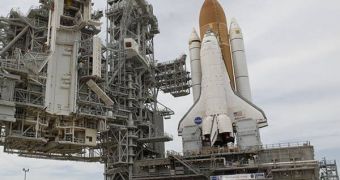Officials at the American space agency have deemed it safe for the Atlantis space shuttle to lift off one day earlier than the previously planned May 12th launch date. The move was prompted by concerns that the fifth and final Hubble servicing mission could adversely affect the schedule that NASA had devised for the launch pads at the Kennedy Space Center. For the STS-125 mission, which will last about 11 days, the KSC needed to make both its pads available, one for Atlantis, and the other one for the Endeavor shuttle. The second spacecraft will stand by to provide help, if Atlantis needs it, in a potential rescue mission codenamed STS-400.
After completing a full-scale review of the shuttle's readiness to fly, mission managers and engineers have decided that it's OK for Atlantis to blast off at 2:01 pm EDT, on May 11th. The craft will take off from the spaceport's Launch Pad 39A and will sport a crew of seven astronauts.
Atlantis will carry two weeks’ worth of supplies and life support, so the seven members of the crew will have no problem enduring, if the issue they report does not affect the very structural integrity of the ship. NASA estimates that the risks of STS-125 going wrong are very small, but the delicate nature of the mission – namely the fact that the astronauts cannot dock on the ISS – has prompted extra precautions. This state of affairs will allow for Endeavor to be thoroughly prepared for the intervention. It will not be rushed to the rescue, and each of its “steps” will be carefully calculated.
The mission astronauts will perform a series of five spacewalks, during which time they will upgrade the Hubble Space Telescope with two new instruments, the most sensitive orbit-based ultraviolet spectrograph – the Cosmic Origins Spectrograph (COS) tool – and the Wide Field Camera 3 (WFC 3), which is a panchromatic wide-field camera that can shoot in infrared, visible, and ultraviolet light.
In addition to these instruments, the servicing mission will also attach a Soft-Capture Mechanism (SCM) tool to the venerable space telescope. This will ensure that an unmanned spacecraft can be sent in 2014 – when the observatory is scheduled to be decommissioned – to dock on the structure and aid in its de-orbiting. This is a very important step, because Hubble would otherwise dive uncontrollably in the atmosphere, and could fully disintegrate upon reentry.
Atlantis will also deliver a brand new set of six gyroscopes to the telescope, meant to replace its aging directional system, which guides the entire structure through space. All batteries aboard the observatory will also be replaced, and a new outer blanket layer will be installed. Hopefully, this will provide Hubble with a higher degree of insulation, and could facilitate discoveries with the world's most famous observatory. These changes to the instrument will allow it to remain competitive until at least 2014, NASA officials hope.

 14 DAY TRIAL //
14 DAY TRIAL //